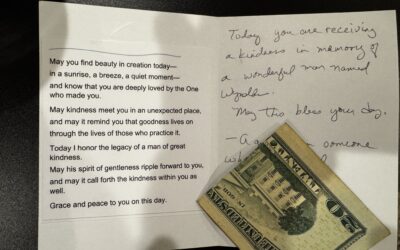Hagar knew the desert and she knew grief. Two times she mourned in the desert, and her tears are the first ones recorded in the Bible.[1] She was not the favored wife of Abraham but instead was Sarah’s servant. Sarah gave Hagar to Abraham in the most intimate way while trying to “help God” keep His promise to Abraham. When Hagar became pregnant, bitterness and rivalry ensued between the women, causing Hagar to run away to the desert. She returned to Sarah per God’s request, but when Sarah finally gave birth and the promised son, Isaac, was weaned, Hagar’s son, Ishmael taunted the boy. In reaction, Sarah sent Hagar and Ishmael away with only some food and water which Abraham had given. In the desert again, Hagar mourned for her son who was dying under a bush after their supplies ran out. How used, rejected, and disposable she must have felt. In the Genesis account of her life, Hagar cycled through times of orientation, disorientation, and reorientation and could have well-scripted Psalm 13. In this paper I shall explore these three stages of transition and transformation in Hagar’s life, giving attention to her disorientation through the song of lament in Psalm 13.
Background and Orientation
Genesis 21:9-21 records the dramatic unfolding events of Hagar’s life. Though Hagar had come from the socially and politically advanced country of Egypt, her status as a maidservant and foreigner gave her a disadvantage among Hebrew women. (African American author and biblical scholar Nyasha Junior, cites Hagar as a beloved woman among the African American community as she resonates with their experiences and concerns.[2] Hagar also holds a central place in Arab legends and ancient genealogies and is honored by Muslims.[3] She also represents victimization in some countries that relate to oppression.) [4]
Though a maidservant’s role was not the same as that of chattel slavery, Hagar legally “belonged” to Sarah. Some interpreters speculate that Abraham’s gifts of menservants and maidservants from Egypt (Genesis 12:16) may have brought Hagar to them. Though we do not know how this arrangement began, the Scriptures are clear that Hagar answered to Sarah, not Abraham (Gen. 16:6).
Hagar, as Sarah’s maidservant, received a great “promotion” when Sarah had Abraham take her as a concubine and become a sort of surrogate mother for Sarah. Though the Bible does not describe Hagar’s emotions at this time, perhaps she felt like a person who won a lottery. For a woman in Hagar’s position, bearing the child of a leader would be an honor, raise her social status, and make her a concubine, or secondary wife. She might eventually look forward to being the mother of the tribe’s leader, making her a “queen” of sorts.[5] Perhaps Hagar found a time of orientation as her lot in life changed, seemingly for the good. However, this time of orientation would quickly change to disorientation.
Disorientation
Hagar became pregnant with Abraham’s son, not by her choice but by Sarah’s insistence. The Bible is not clear as to the details of what happened between Sarah and Hagar, but Sarah felt that Hagar despised her after Hagar became pregnant. In reaction, Sarah began to mistreat Hagar to the point Hagar felt the need to run away (Gen 16:1-8). The orientation time of pregnancy and exalted status likely felt short-lived for Hagar. She became a disoriented runaway in the desert until an angel of God approached her calling her by her name and asking her, “Where have you come from and where are you going?” These poignant questions are important to answer during any season of disorientation. One needs to determine where they have come from and where they are going. God tells Hagar to go back to Sarah and tells her that He will increase her descendants; yet, with that good news, He also delivers some not-so-encouraging news. The angel tells her that her son will live in hostility toward his brothers (Gen 16:9-12).
Her disorientation turns to reorientation when she realizes that in her misery and distress, God saw her. Hagar is the only person in the Bible who gives a name to God, as she names him El Roi, the God who sees. Genesis 16:3 states an important aspect of reorientation as Hagar states, “I have seen the God who has seen me.” To reorient, one must see God.
Reorientation and back to disorientation
For the next thirteen years, as Ishmael grows life would go well for Hagar. She is now part of the family of Abraham, having mothered the son of one who would be the father of many nations. The Scriptures do not give many details of Hagar’s life during this time, but there is no record of her leaving or being disoriented. After waiting for many years, God fulfills the promise originally given to Abraham and Sarah that they would bear a son. Isaac is born and after he is weaned, Hagar’s son Ishmael begins to taunt the young boy. Once again, Sarah is angry and as a protective and perhaps jealous mama, she sends Hagar away. Hagar does not seem to remember the name she had previously given God, “the God who sees.” Genesis records Hagar’s difficult, disorienting situation.
But Sarah saw that the son whom Hagar the Egyptian had borne to Abraham was mocking, and she said to Abraham, “Get rid of that slave woman and her son, for that woman’s son will never share in the inheritance with my son Isaac.”
The matter distressed Abraham greatly because it concerned his son.
But God said to him, “Do not be so distressed about the boy and your slave woman. Listen to whatever Sarah tells you, because it is through Isaac that your offspring will be reckoned.
I will make the son of the slave into a nation also, because he is your offspring.”
Early the next morning Abraham took some food and a skin of water and gave them to Hagar. He set them on her shoulders and then sent her off with the boy. She went on her way and wandered in the Desert of Beersheba.
When the water in the skin was gone, she put the boy under one of the bushes.
Then she went off and sat down about a bowshot away, for she thought, “I cannot watch the boy die.” And as she sat there, she began to sob. (Genesis 21:9-16)
The cycle repeats and Hagar laments.
Hagar loved her son, Ishmael, yet felt helpless to help him. She had not asked for her situation and after wandering in the desert again, their water ran out. Ishmael was dying, and life felt cruel and unfair. You would think a mother would hold her son as he cried in pain as his dry mouth longed for water; however, she left him under one of the bushes and sat a bowshot away. Depending on who is shooting the arrow, this distance would vary. For an archer (which ironically, is what Ishmael became), the distance might be several football fields. (For me, the distance might be two feet.) She kept her distance because she could not bear to watch her son die (v. 16). She did the opposite of “leaning in” to his needs; she leaned away. She kept her distance, probably to protect her emotions. Some scholars promote her as a harsh, unloving woman, but this does not seem consistent with her pain at the thought of losing Ishmael. Rather, she portrays a woman broken in despair.
Once again, Hagar is seen mourning in the desert. According to Israel’s social standards, the desert was the least desirable place. In some traditions, the desert was “further conceptualized as a place of non-existence and thus as the abode of the dead.”[6]
Poet Rosanna Warren ends her poem entitled, “Hagar,” portraying a dark lament from Hagar’s pain:
Not to see him die, I pressed my hand
into my sockets, but his cry broke through all bone and fiber, shattered the seal blue
of heaven to wound your vast and hovering ear,
Lord of the desert, Lord who cannot hear
our prayers, but the deathwail of a child
swirling from the rootclutch in the wild.
You are the God of stone and stony eyes
and water dripping through stone crevices
to the swollen tongue that cannot taste your name.
Lord of thistle and mica, Here I am.[7]
Hagar and Psalm 13
The first four verses of Psalm 13 well reflect Hagar’s time in the desert, sobbing, unable to find the face of God. The “God who sees” could not be seen.
How long, LORD? Will you forget me forever? How long will you hide your face from me?
How long must I wrestle with my thoughts and day after day have sorrow in my heart? How long will my enemy triumph over me? Look on me and answer, LORD my God.
Give light to my eyes, or I will sleep in death, and my enemy will say, “I have overcome him,” and my foes will rejoice when I fall.
Once again, Hagar felt hopeless and mistreated. The God who had once seen her had suddenly been blinded, according to her thoughts. One can only imagine the anguish of running out of water and then watching your beloved son die. While scholars vary on whether Hagar was cruel toward Ishmael, protecting her heart, or giving him a burial as he died,[8] Hagar’s anguish felt intense. How she must have wrestled with thoughts of injustice and abandonment by God, Abraham, and Sarah. Once her family, Abraham and Sarah now felt like enemies. Who but an enemy could treat one as a prisoner of war, marching toward death? From Hagar’s view, her enemies had triumphed.
Having earlier named God when she said, “I have seen the God who sees me.” (Gen 16:13), the light is now gone from Hagar’s eyes. Psalm 13:3 expresses a longing for light in the eyes, but darkness prevails. This psalm mirrors Hagar in the desert, waiting for Ishmael to die.
In his essay on ritual weeping and its function, historian Ebersole studies Hagar, opining that “Gen 21 showcases the power of ritual weeping not only in opposing the breakdown of a social system but also in advancing its restoration.[9] Hagar’s lament in the desert prepares her for verses 5 and 6 in Psalm 13, as she once again cycles toward reorientation.
But I trust in your unfailing love; my heart rejoices in your salvation.
I will sing the LORD’s praise, for he has been good to me.
As Hagar vulnerably laments her abandonment in the desert, God helps her gain reorientation as once again she “sees the God who sees her.” This time though, she hears the God who hears her.
Reoriented Again
As Hagar sat sobbing, a bowshot away from her dying son, God helped her see Him once again. Genesis 21:17-21 reminds us that in one’s darkest hour, God sees, and He hears.
God heard the boy crying, and the angel of God called to Hagar from heaven and said to her, “What is the matter, Hagar? Do not be afraid; God has heard the boy crying as he lies there.
Lift the boy up and take him by the hand, for I will make him into a great nation.”
Then God opened her eyes and she saw a well of water. So she went and filled the skin with water and gave the boy a drink.
God was with the boy as he grew up. He lived in the desert and became an archer.
While he was living in the Desert of Paran, his mother got a wife for him from Egypt.
In this second encounter with God, the well that could quench Ishmael’s and Hagar’s thirst was not visible to Hagar while she was in distress; yet, the same God who saw her continued to see her and hear her cries. God sees and hears us, but we do not always see and hear Him. Her eyes had to be opened to see God’s provision for her. She had lost sight of the well where God had seen her.
These two “well encounters” may be near the same place.[10] In both encounters, God saw and heard Hagar’s pain. In both encounters, her heart and eyes were opened to God’s loving care for her. When her eyes are opened, she encounters God who tells her not to be afraid and to “lift the boy up and take him by the hand, for I will make him into a great nation.” Her reorientation with God also brought restoration to her relationship with her son. Reorientation often brings healing to stressed relationships.
In her article, “The Other Woman,” Debbie Blue notes the parallel between Hagar’s story and Abraham’s story. Hagar takes Ishmael into the desert for imminent death until an angel of God shows her a well. Abraham takes Isaac to Mount Moriah where death seems sure until an angel speaks and shows him a ram. She further notes something many scholars think likely. After Sarah dies, Abraham marries Keturah. “According to Midrashic tradition, ‘Keturah’ is Hagar’s real name—the other is just a description [meaning “other woman”][11]. Blue conjectures as she continues, “So Abraham doesn’t cut off the counternarrative. He embraces it, takes it into his heart. He lies in bed with it—makes love with Hagar again…”[12]
Conclusion
Hagar’s life reminds one that God hears and knows the distress of his children, no matter what happens. He cares, always. Even if God had not provided the well and Ishmael had died, the story would not have been over, because there is eternal life for those who belong to God. However, for this purpose, God would have Ishmael live. God was keeping a promise. He always keeps promises.
For your kingdom is an everlasting kingdom. You rule throughout all generations. The LORD always keeps his promises; he is gracious in all he does.
The LORD helps the fallen and lifts those bent beneath their loads. (Psalm 145:13-14 NLT)
Hagar’s transformation took place when her eyes were opened and she saw a well of water. Had that well always been there? We do not know, but we do know that God provided what was needed. For me, transformation takes place when I believe that God sees, hears, and cares, even when His answers are not as I wish. Transformation comes when my eyes are open to see what God is providing for me, no matter how painful the situation. He always provides through His Spirit what is humanly impossible. When I open my eyes to see God (Eph 1:17), like Hagar I find the well of living water that God has so graciously supplied. I must trust His love.
But I trust in your unfailing love; my heart rejoices in your salvation.
I will sing to the LORD, for he has been good to me. (Psalm 13:5-6)
Bibliography
Blue, Debbie. “The Other Woman,” The Christian Century, November 24, 2014. https://www.christiancentury.org/article/2014-11/other-woman, accessed June 28, 2020.
Haldar, A. The Notion of the Desert in Sumero-Accadian and West-Semitic Religions. Uppsala: Lundequistska Bokhandeln, 1950. Cited in https://www-oxfordscholarship-com.ezproxy.regent.edu/view/10.1093/oso/9780198745327.001.0001/oso-9780198745327, accessed June 28, 2020.
Junior, Nyasha. Reimagining Hagar: Blackness and Bible. NY: Oxford University Press, 2019.
Kadari, Tamar. “Keturah: Midrash and Aggadah.” The Encyclopedia of Jewish Women, https://jwa.org/encyclopedia/article/keturah-midrash-and-aggadah, accessed, July 1, 2020.
Koziova, Ekaterina E. “Maternal Grief in the Hebrew Bible.” Oxford Scholarship Online, June 17, 2017, https://www-oxfordscholarship-com.ezproxy.regent.edu/view/10.1093/oso/9780198796879.001.0001/oso-9780198796879-chapter-2, accessed June 28, 2020.
Plumptre, E.H. “The Bible Educator, Vol 1.” London: Cassell Petter and Galpin, (1877), 101.h.184.
Sellin, Christine Petra. Fractured Families and Rebel Maidservants: The Biblical Hagar in Seventeenth-Century Dutch Art and Literature. United Kingdom: Bloomsbury Academic, 2006.
Talhami, Ghada Hashem. “Historical Dictionary of Women in the Middle East and North Africa.” Historical Dictionaries of Women in the World. Lanham, Md: Scarecrow Press, 2013. http://search.ebscohost.com.ezproxy.regent.edu:2048/login.aspx?direct=true&db=e000xna&AN=547990&site=ehost-live, accessed June 28, 2020.
Warren, Rosanna. “Transactions of the American Philosophical Society, New Series, Vol 106, No. 1. Earthworks: Selected Poems. American Philosophical Society, 2016. https://www.jstor.org/stable/44650974, accessed: 28-06-2020.
[1] Debbie Blue, “The Other Woman,” The Christian Century, November 24, 2014, https://www.christiancentury.org/article/2014-11/other-woman
[2] Nyasha Junior, Reimagining Hagar: Blackness and Bible (NY: Oxford University Press, 2019), 2.
[3] Ghada Hashem Talhami,. “Historical Dictionary of Women in the Middle East and North Africa.,” Historical Dictionaries of Women in the World. (Lanham, Md: Scarecrow Press, 2013), http://search.ebscohost.com.ezproxy.regent.edu:2048/login.aspx?direct=true&db=e000xna&AN=547990&site=ehost-live, accessed June 28, 2020.
[4] Hagar was a noticeable object of compassion and elevated status in 17th century Dutch artwork. Christine Petra Sellin, Fractured Families and Rebel Maidservants:The Biblical Hagar in Seventeenth-Century Dutch Art and Literature (United Kingdom: Bloomsbury Academic, 2006), 156.
[6] A. Haldar, The Notion of the Desert in Sumero-Accadian and West-Semitic Religions (Uppsala: Lundequistska Bokhandeln, 1950), 14. Cited in https://www-oxfordscholarship-com.ezproxy.regent.edu/view/10.1093/oso/9780198745327.001.0001/oso-9780198745327, accessed June 28, 2020.
[7] Rosanna Warren, “Transactions of the American Philosophical Society, New Series, Vol 106, No. 1, Earthworks: Selected Poems, (American Philosophical Society, 2016), https://www.jstor.org/stable/44650974, accessed: 28-06-2020
[8] Scholars Hamilton and White argue that Hagar’s casting of Ishmael under the bush was depositing him into a grave with dignity, adding that her treatment of Ishmael parallels Abraham’s treatment of Hagar. The care Abraham showed in giving provisions to her is matched by her watchful obervance of her son.
Ekaterina E. Koziova, “Maternal Grief in the Hebrew Bible,” Oxford Scholarship Online, June 17, 2017, https://www-oxfordscholarship-com.ezproxy.regent.edu/view/10.1093/oso/9780198796879.001.0001/oso-9780198796879-chapter-2, accessed June 28, 2020.
[9] Ekaterina E. Koziova, “Maternal Grief in the Hebrew Bible,” Oxford Scholarship Online, June 17, 2017, https://www-oxfordscholarship-com.ezproxy.regent.edu/view/10.1093/oso/9780198796879.001.0001/oso-9780198796879-chapter-2, p. 2, accessed June 28, 2020.
[10] It is possible that both encounters with God at the well are at the same well. Beersheba was a desert region as was Shur. Both were on the way to Egypt. E.H. Plumptre, “The Bible Educator, Vol 1,” (London: Cassell Petter and Galpin, 1877), 174. 101.h.184.
[11] Tamar Kadari, “Keturah: Midrash and Aggadah,” The Encyclopedia of Jewish Women, https://jwa.org/encyclopedia/article/keturah-midrash-and-aggadah, accessed, July 1, 2020.
[12] Debbie Blue, “The Other Woman,” The Christian Century , November 4, 2014, https://www.christiancentury.org/article/2014-11/other-woman, accessed June 30, 2020.



0 Comments